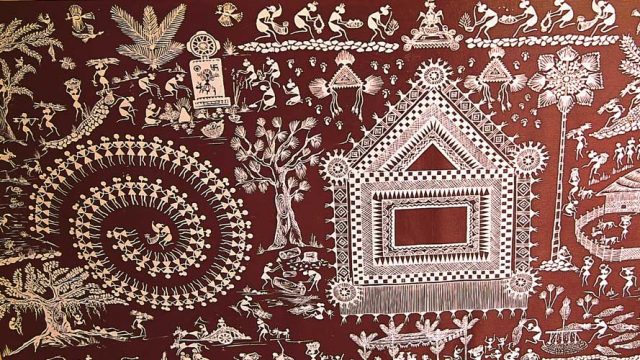The richness of Maharashtra’s heritage is evident from the sheer range of the state’s traditional arts and crafts. Although the gorgeous Paithani may well be its most famous offering, there are other, equally popular handicrafts to be bought here. From gorgeous fabrics and saris to the world-famous mural paintings of Warli and Kohlapur’s leather ware and stunning jewellery, shoppers will be spoilt for choice.
Textiles

Maharashtra is one of the leading cotton producing states in the country. With such rich resources, it is only obvious that most of the traditional fabric-based arts and crafts that are made in Maharashtra use this material extensively. While Narayan Peth was originally a cotton and silk weave, Paithani saris are mainly silk saris with heavy, ornamented borders. The famous mashroo and himroo are luxurious fabrics made by weaving cotton and silk together with the help of a special loom.
Narayan Peth Saris
Narayan Peth saris come from the Solapur District of Maharashtra. Characterized by broad borders and vibrant colours, the body of the sari has small motifs, in the shape of rudrakshas. Woven from cotton and silk, these saris have had a place in Maharashtra’s culture since 200 BCE. The most appealing aspect of a Narayan Peth sari is its borders which contrasts against the colour of the rest of the sari.
Paithani Sari
The Paithani sari originates from the area of Paithan, in Aurangabad District. This pure silk woven sari is distinctive for the heavy gold zari work on it, especially on the pallav. The saris have deep, rich colours, a heavy gold pallav with motifs such as flowers, fruits and birds such as peacocks, and small gold bootis (motifs) strewn all over the length of the material.
The specialty of the Paithani saris is that mechanical means such as jacquard are not used while creating designs on the sari. The designs are completely handcrafted. Paithanis are quite expensive, and usually worn on special ceremonies such as marriages and festivals.
Mashru and Himroo
Mashru and Himroo originate from the Aurangabad District in the Marathwada region of Maharashtra, and were once used to make clothes for nobles. Cotton and silk is woven together with the use of a special loom, resulting in a luxurious, distinctive feel.
Mashru and Himroo
These fabrics owe their opulence to the use of gold and silver threads for weaving. As a result, the final cloth has a tinge of gold across it. With time, the tradition of weaving by hand has lessened as machines gradually took over. However, the bold patterns and striking colours have helped retain the popularity of these fabrics. Although both Mashru and Himroo are usually spoken of together, the process of weaving differs. Creating Himroo requires more skill and is slightly finer, and so it is considered more exclusive than Mashru.
Warli Paintings
Warli paintings, a tribal art form, are mural paintings with characteristic graphic vocabulary. These paintings originated from the Warli tribe living in mountainous and coastal areas of the Maharashtra-Gujarat border. The elements that make up the painting are basic shapes – circles, triangles and squares – that make up wholes to represent daily human life. While the triangles and the circles are assumed to having been derived from the mountains and the Sun, the squares represent a piece of enclosed land. The central motif in most ritual paintings is the square and within the square is the drawing of Palaghata, the goddess of fertility. Around this are scenes representing fishing, hunting, farming, festivals, dancing, etc.
These paintings, which are attributed to a culture that can be dated back to the 2000 BCE, somewhat resemble the earliest paintings found at the Rock Shelters in Bhimbetka near Bhopal in Madhya Pradesh.
Today, Warli paintings have found a wider canvas with designers and artists also imitating these on clothes, bags, book covers, etc.
Kolhapuri Chappals

Made of leather, Kolhapuri chappals are famous for their characteristic rustic style and look, and durability. Earliest records of Kolhapuri chappals date back to the 13th century CE. These locally handmade, distinctive slippers are open-toed with a T-strap, and the leather is coloured with vegetable dyes. The original slippers were made of buffalo hide and had a thick sole, which made them extremely hardy and durable. However, many different designs have evolved over the years.
Jewellery of Kolhapur
Most of Maharashtra’s traditional jewellery draws from the designs that were worn by the royals of Maratha and Peshwa kingdoms. The most famous of these come from Kolhapur. The Kolhapuri saaj is a neckpiece with golden beads and 21 leaf-shaped pendants. This necklace is considered auspicious for married Maharashtrian women, and most of them possess this piece of jewellery. Another famous ornament is the nath, a nose ring comprising a gold string interwoven with pearls, precious and semi-precious stones.




